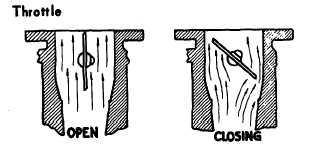TM 5-4240-501-14&P
The air pressure above the fuel in the bowl pushes the
fuel down in the bowl and up in the nozzle to the
discharge holes. At the same time the air rushes into the
carburetor air horn and through the venturi where its
velocity is greatly increased.
The nozzle extending through this air stream acts as an
air foil, creating a still lower pressure area on the upper
side. This allows the fuel to stream out of the nozzle
through the discharge holes into the venturi where it
mixes with the air and becomes a combustible mixture
ready for firing in the cylinder.
A small amount of air is allowed to enter the nozzle
through the bleeder. This air compensates for the
difference in engine speed and prevents too rich a
mixture at high speed.
The story of carburetion could end right here if the
engine were to run at only one speed and under ideal
conditions.
However,
since
smooth
economical
operation is desired at varying speeds, some additions
must be made to the carburetor.
The ideal combustion mixture is about 14 or 15 pounds
of air, in weight, to one (1) pound of gasoline.
Remember that an engine operating under heavy load
requires a richer mixture than under light load. In order
to regulate the mixture, we place in the carburetor a
threaded needle valve with a tapered point which
projects into the end of the nozzle. See Fig. 16.
To adjust the carburetor for maximum power, run the
engine at the desired operating speed, then turn in the
needle valve until the engine slows down, which
indicates a lean mixture. Note the position of the needle
valve, then turn the needle valve out until the engine
speeds up and then slows down, which indicates a rich
mixture, Note the position of the needle valve, then turn
the needle valve to midway between the lean and rich
position. Adjust the mixture to the requirement for each
engine. Remember that too lean a mixture is not
economical. It causes overheating, detonation, and
short valve life. Also, since there is no accelerator pump,
the mixture must be rich enough so that the engine will
not stop when the throttle is suddenly opened. Engines
which run at constant speeds can be slightly leaner than
those whose use requires changes in speed.
THEORIES OF OPERATION
Carburetion
The inset of Fig. 16 shows what happens when the
needle valve is turned too far. A square shoulder is
produced on the taper. It is possible, of course, to adjust
the carburetor with the needle valve in this condition, but
it is quite difficult, because a small movement of the
needle makes a big difference in the amount of fuel that
can enter the nozzle. And, if you do get it adjusted, the
vibration can soon throw it off.
Figure 17.
To allow for different speeds, a flat disc called a butterfly,
mounted on a shaft, is placed in the carburetor throat
above the venturi. This is called the throttle. See Fig.
17.
The throttle in the wide open position does not affect the
air flow to any extent. However, as the throttle starts to
close, it restricts the flow of air to the cylinder and this
decreases the power and speed of the engine. At the
same time it allows the pressure in the area below the
butterfly to increase. This means that the difference
between the air pressure in the carburetor bowl and the
air pressure in the venturi is decreased, the movement of
the fuel through the nozzle is slowed down; thus the
proportion of fuel and air remain approximately the
same. As the engine speed slows down to idle, this
situation changes. See Fig. 18.
At idle speed the throttle is practically closed, very little
air is passing through the venturi and the pressure in the
venturi and in the float bowl are about the same. The
fuel is not forced through the’ discharge holes, and the
mixture tends to become too lean.
Idle Valve
To supply fuel for the idle, the nozzle is extended up into
the idle valve chamber. It fits snugly in the upper body to
prevent leaks. Because of this tight fit, the nozzle must
be removed before upper and lower bodies are
separated, or the nozzle will be bent.
9
14

